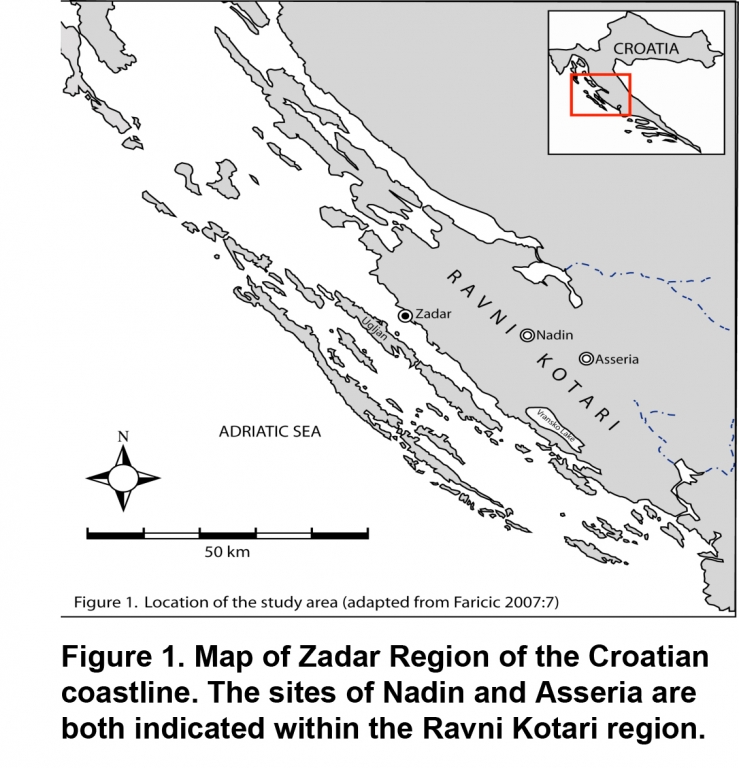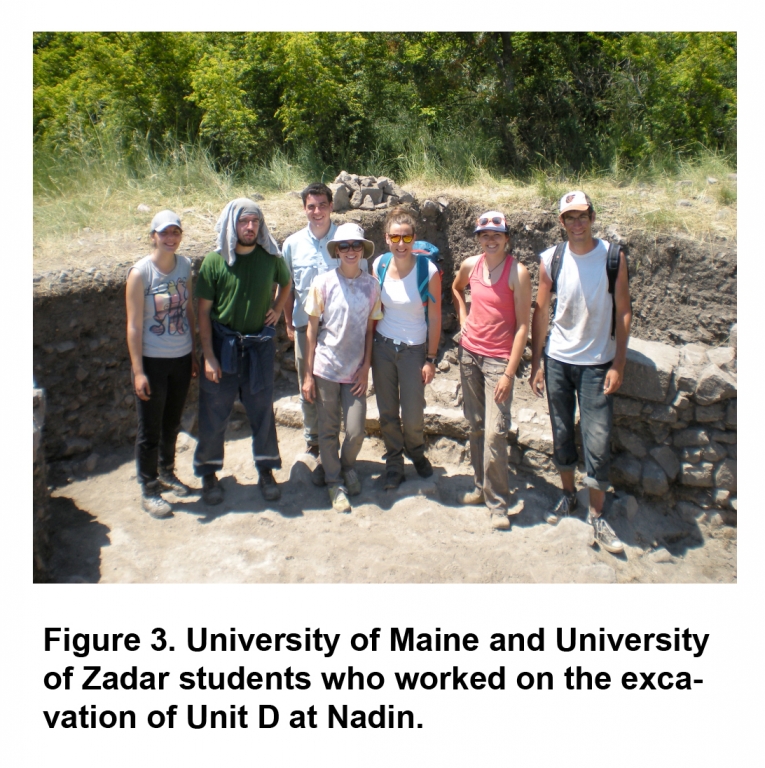Urban Development and Landscape Change at the Nadin Archeological Site, Croatia
Urban Development and Landscape Change at the Nadin Archeological Site, Croatia
May 2015 – June 2015
Field Team Members: Marissa Bovie, Dr. Gregory Zaro
Funding Support: Churchill Exploration Fund
Background: The purpose of this expedition was to investigate the process of urbanization at the archaeological site of Nadin, Croatia. Nadin is located near the 3,000 year old city of Zadar, a city whose history stretches from Iron Age origins, through Roman colonization, medieval settlement, Venetian occupation, and into the present era (Chapman et al. 1996; Jovic? Gazic? 2011a). Nadin in particular played a part as a portion of the hinterland of Zadar. Nadin is a moderately sized site in Croatia’s Ravni Kotari region, an area key for livestock and agriculture along the coast. It has a written history of occupation spanning back 2,500 years. The current project aims to establish the chronology of Nadin, with the intent to build a range of knowledge concerning human-environmental interactions within the Zadar region.
Field Work: In the summer of 2014, I was able to travel to Croatia with Dr. Gregory Zaro to begin the primary stages of the project, thanks to the Center for Undergraduate Research. This process involved meeting with academic professionals within Croatia to gain their perspective and input for an interdisciplinary project. This allowed for important connections to people with a variety of areas of expertise, to create a multidisciplinary team. I also spent time at the archaeological field school run by the University of Zadar, to gain an idea of the field methods being utilized within the region. This provided a useful point of comparison to the research we intended to begin at Nadin.
In May of 2015, I traveled to Zadar, Croatia, with support from the Churchill Fund and the Getty Archaeological Study Fund. I made the journey with eleven other University of Maine students who were enrolled in Dr. Zaro’s field archaeology course. The course focused on archaeological research design and excavation at Nadin. This work was completed along with archaeology students from the University of Zadar, and partially supported by a National Geographic Society grant awarded to Dr. Zaro. The excavation was centered on the area within the megalithic walls of the site, an area likely to contain the largest number of temporal phases, based on previous excavations (Chapman et al. 1996). For this field season, excavation units were scattered across Nadin, as a sampling strategy to better understand the archaeological record at Nadin and plan for the future. This scattered arrangement also allowed us to attain the widest possible data set for depositional sequences. Data was collected from a series of excavation units in the form of cultural artifact recovery, botanical remains, and fauna. Material was collected at several locations for radiocarbon dating and relative chronological indicators like stylistic and formal variation in ceramics and other artifact classes. Macrobotanical and faunal remains were also collected to provide information on subsistence and the surrounding landscape. The focus of my participation was primarily in Unit D, alongside several Croatian and University of Maine students. At this time, I also began a side project, collecting plaster samples from multiple standing walls around Nadin, as well as from walls and surfaces uncovered in the five excavation units. A total of 35 samples were collected and transported back to the University of Maine, with the goal of investigating the relationship of sedimetological characteristics and chronology of masonry techniques.
In June, excavations were completed with the termination of the University of Zadar’s field period. After this point, I was engaged in washing faunal remains and ceramics in the laboratory at the University of Zadar. During this time I also assisted in cataloguing the findings from this field season for either storage or transport to specialists in Zagreb, Croatia.
Future Work: The future of this project ultimately lies in the collaborative field program with the University of Zadar and the University of Maine. It is through continued data collection and research that the project will be able to answer larger questions about human agency and landscape change in this region. The data collected thus far will provide the foundation for the stratigraphic sequences present at the site, as well as information about the types of plants and animals in the region at various points in the site’s history. This will create a basic structure for looking at environmental changes over time. My senior thesis this year will focus on the plaster samples taken from the site as a potential dating method. It will investigate sedimentary and mineralogical differences between the samples to see if different compositions of materials were used at varying time points throughout the history of the site of Nadin.
References:
Chapman, John, Robert Shiel, and Aime BatoviB (1996). The Changing Face of Dalmatia: Archaeological and Ecological Studies in a Mediterranean Landscape. Leicester University Press, London.
Faricic, Josip and Damir Magas (2007). Geografska obiljezja i njihova funkcionalna povezanost s toponimima otoka Ugljana. In Toponimija Otoka Ugljana, pp. 5-45, Centar za jadranska onomasticka istrazivanja, University of Zadar, Zadar.
Jovic Gazic, Vedrana (2011a). Urban development from Late Antiquity to the Middle Ages:




